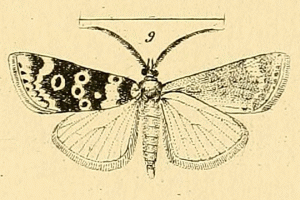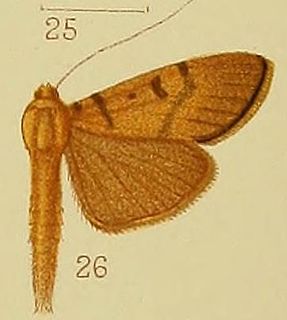
Pyraustinae is a large subfamily of the lepidopteran family Crambidae, the crambid snout moths. It currently includes over 1,400 species; most of them tropical but some found in temperate regions including both North America and Europe.

Spilomelinae is a very species-rich subfamily of the lepidopteran family Crambidae, the crambid snout moths. With 4,132 described species in 340 genera worldwide, it is the most speciose group among pyraloids.

Crocidophora is a genus of moths of the family Crambidae. The genus was erected by Julius Lederer in 1863.

Aglossa ocellalis is a species of snout moth in the genus Aglossa. It was described by Julius Lederer in 1863 and is known from Uganda and the Democratic Republic of the Congo. There is one record of an accidental introduction from Scotland.
Omphalocera cariosa is a species of snout moth, and the type species in the genus Omphalocera. It was described by Julius Lederer in 1863. It is found from North America to Brazil.
Elophila atlantica is a moth in the family Crambidae. It was described by Eugene G. Munroe in 1972. It is found on North America, where it has been recorded from Nova Scotia, Florida, Maine, Maryland and South Carolina.
Prionapteryx achatina is a moth in the family Crambidae. It was described by Zeller in 1863. It is found in North America, where it has been recorded from Arizona, Colorado, Florida, Georgia, Indiana, Maryland, Massachusetts, Minnesota, New Hampshire, New Jersey, North Carolina, Ohio, South Carolina and Wisconsin.
Lipocosma septa, the exposed lipocosma moth, is a moth in the family Crambidae. It was described by Eugene G. Munroe in 1972. It is found in North America, where it has been recorded from Florida, Georgia, Maryland, North Carolina, Oklahoma, South Carolina, Texas and Virginia.

Crocidophora serratissimalis, the angelic crocidophora moth or sawtoothed crocidophora, is a moth in the family Crambidae. It was described by Zeller in 1872. It is found in North America, where it has been recorded from Quebec and New England to South Carolina, west to Manitoba and possibly Texas.

Crocidophora tuberculalis, the pale-winged crocidiphora moth, is a moth in the family Crambidae. It was described by Julius Lederer in 1863. It is found in North America, where it has been recorded from Alabama, Florida, Georgia, Illinois, Indiana, Maine, Maryland, Massachusetts, Mississippi, New Hampshire, North Carolina, Ohio, Oklahoma, Ontario, Quebec, South Carolina, Tennessee, Texas, Virginia, West Virginia and Wisconsin.
Euclasta maceratalis is a moth in the family Crambidae. It was described by Julius Lederer in 1863. It is found in northern Australia, where it has been recorded from Queensland.
Ostrinia obumbratalis, the smartweed borer, is a moth in the family Crambidae. It was described by Julius Lederer in 1863. It is found in North America, where it has been recorded from New Brunswick and Manitoba to Louisiana and Florida.

Saucrobotys futilalis, the dogbane saucrobotys moth, is a moth in the family Crambidae. It was described by Julius Lederer in 1863. It is found in North America, where it has been recorded from the north-east to British Columbia and south to Texas and California.
Analyta albicillalis is a moth in the family Crambidae. It was described by Julius Lederer in 1863. It is found in Indonesia and Australia, where it has been recorded Queensland.
Dichocrocis frenatalis is a moth in the family Crambidae. It was described by Julius Lederer in 1863. It is found in India, where it has been recorded from the Nicobar Islands.

Syllepte glebalis is a moth in the family Crambidae. It was described by Julius Lederer in 1863. It is found in Cameroon, the Democratic Republic of the Congo, Ivory Coast, Madagascar, Nigeria, Sierra Leone, Zambia and Zimbabwe.
Omiodes spoliatalis is a moth in the family Crambidae. It was described by Julius Lederer in 1863. It was described from North America.

Palpita freemanalis, or Freeman's palpita moth, is a moth in the family Crambidae. It was described by Eugene G. Munroe in 1952. It is found in North America, where it has been recorded from Alabama, Illinois, Indiana, Louisiana, Maryland, Mississippi, North Carolina, Oklahoma, South Carolina, Tennessee and Texas.

Pilocrocis ramentalis, the scraped pilocrocis moth, is a moth in the family Crambidae. It was described by Julius Lederer in 1863. It is found in North America, where it has been recorded from Ontario to Florida and from Wisconsin to Texas. It is also found in Mexico, Honduras, Costa Rica, Cuba and Puerto Rico. It is an introduced species on the Galápagos Islands. The habitat consists of open woods, clearings and damp areas.

Margaroniini is a tribe of the species-rich subfamily Spilomelinae in the pyraloid moth family Crambidae. The tribe was erected by Charles Swinhoe and Everard Charles Cotes in 1889.









